Physical Inactivity is More Common among Racial and Ethnic Minorities in Most States
Posted on byJoin Active People, Healthy NationSM to help more people become physically active.
Too many adults are inactive, and inactivity levels differ notably by race and ethnicity. These facts make me all the more committed to the success of Active People, Healthy NationSM, CDC’s new initiative to make it easier for people to be physically active where they live, learn, work and play.
Not all people may know how much physical activity affects their health. Being physically active immediately helps you sleep better and feel better. And over time, physical activity reduces your risk of obesity, heart disease, type 2 diabetes, and many cancers. Conversely, inactivity contributes to 1 in 10 premature deaths in the US. Inadequate levels of physical activity are associated with $117 billion in annual healthcare costs.
Adult Physical Inactivity Prevalence Maps, by Race/Ethnicity
State maps of adult physical inactivity released in January 2020 show that physical inactivity across the country is high, with state and territory-level estimates of physical inactivity ranging from 17.3% in Colorado to 47.7% in Puerto Rico. Overall, Hispanics had the highest prevalence of physical inactivity (31.7%), followed by non-Hispanic blacks (30.3%) and non-Hispanic whites (23.4%).
- Five states and Puerto Rico had a physical inactivity prevalence of 30% or higher among non-Hispanic white adults.
- 22 states and Puerto Rico had a physical inactivity prevalence of 30% or higher among Hispanic adults.
- 23 states and the District of Columbia had a physical inactivity prevalence of 30% or higher among non-Hispanic black adults.
So why do some states or racial/ethnic groups have higher levels of physical inactivity? Many things can influence physical activity levels, including the way in which communities and streets are designed. Many people in the US do not have access to safe or convenient places where they can be active, such as community parks, sidewalks, or trails.
Active People, Healthy Nation, in partnership with many organizations, communities, and individuals, aims to help 27 million Americans become more physically active by 2027 to improve overall health and quality of life and to reduce healthcare costs. This initiative promotes the Physical Activity Guidelines for Americans and strategies recommended by the Community Preventive Services Task Force to improve physical activity. By implementing these strategies at the local, state, and national level and by partnering with other Federal agencies and national organizations, Active People, Healthy Nation provides a comprehensive approach to improving physical activity in the United States.
The Active People, Healthy Nation initiative helps community leaders take advantage of proven strategies to make physical activity safe and enjoyable for people of all ages and abilities. Community leaders can:
- Design activity-friendly communities.
- Encourage school and youth physical activity programs.
- Work with populations who are less active to design and implement culturally relevant solutions to reduce disparities in physical activity.
We are issuing a call for individuals, organizations, and community champions to join the movement. Visit CDC’s Division of Nutrition, Physical Activity, and Obesity’s website for more information on why physical activity matters, what your community can do to become more activity-friendly, and how you can work with Active People, Healthy Nation to help 27 million Americans become more physically active by 2027.
Together, we can help states and communities improve physical activity and overall health for all Americans.
Special thanks to Dr. Fulton for contributing this blog in recognition of National Minority  Health Month. This year’s theme, Active & Healthy, highlights the benefits of incorporating small amounts of moderate-to-vigorous physical activity into our schedules as recommended by the 2nd edition of the Physical Activity Guidelines for Americans. Simple changes to one’s daily routine can transform lives and reduce the risk of chronic diseases and other conditions that often are more common or severe among racial and ethnic minority groups.
Health Month. This year’s theme, Active & Healthy, highlights the benefits of incorporating small amounts of moderate-to-vigorous physical activity into our schedules as recommended by the 2nd edition of the Physical Activity Guidelines for Americans. Simple changes to one’s daily routine can transform lives and reduce the risk of chronic diseases and other conditions that often are more common or severe among racial and ethnic minority groups.
2 comments on “Physical Inactivity is More Common among Racial and Ethnic Minorities in Most States”
Comments listed below are posted by individuals not associated with CDC, unless otherwise stated. These comments do not represent the official views of CDC, and CDC does not guarantee that any information posted by individuals on this site is correct, and disclaims any liability for any loss or damage resulting from reliance on any such information. Read more about our comment policy ».



I would like to see the Office of Minority Health offer the following resources…
-Physical activity modifications for people with physical disabilities.
-Physical activity options for people without access to outdoor spaces, parks, recreation centers, etc. Providing “indoor” fitness activities is not the last step, as everyone does not have access to a safe place or home to exercise in.
Thank you,
Really insightful